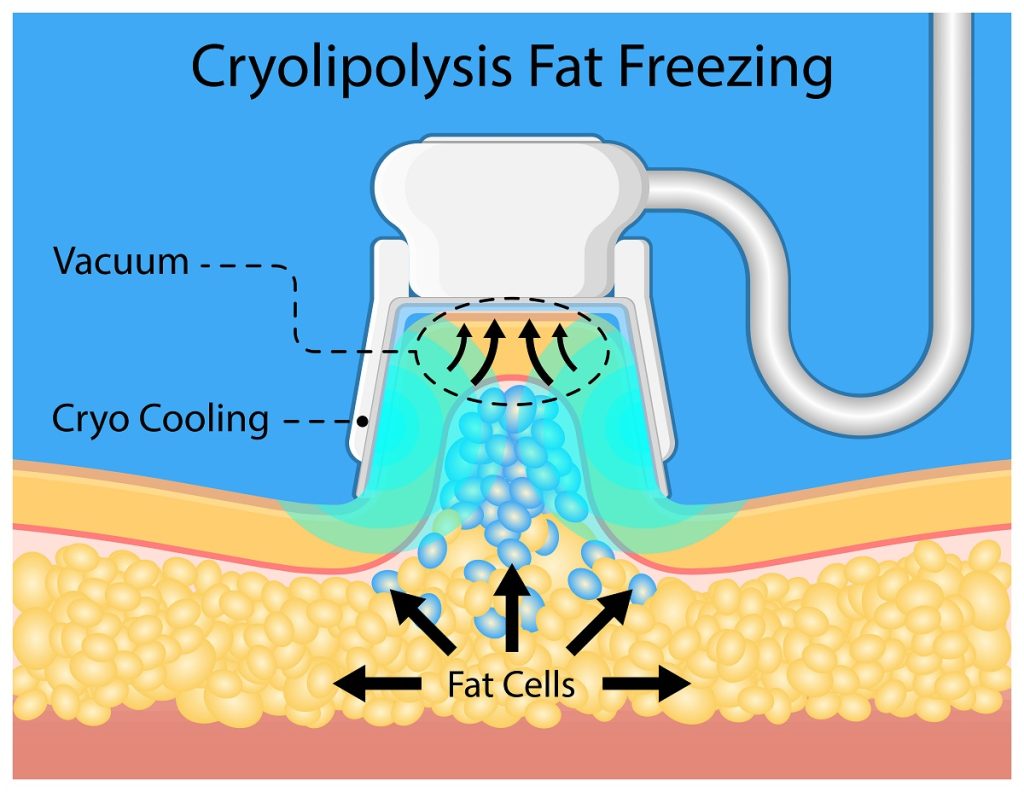Key Takeaways
-
Cryolipolysis is a non-invasive fat reduction treatment that targets and destroys fat cells through cold temperatures. Liposuction is a surgical procedure that physically removes fat using suction.
-
Cryolipolysis usually takes multiple sessions to get optimal results. Liposuction provides direct and more dramatic changes in body shape.
-
Ideal candidates for cryolipolysis have localized fat deposits and are near their target weight. Liposuction is best for those with larger areas of excess fat or individuals seeking significant body reshaping.
-
Recovery times vary widely; with cryolipolysis, there is virtually no downtime, allowing you to resume your normal routine almost right away. In contrast, most liposuction requires days or weeks for a full recovery.
-
Pain levels vary between the two treatments. Cryolipolysis causes some pain from cold sensations, but liposuction carries more pain from the surgical procedure.
-
When thinking about costs, compare how many cryolipolysis sessions you’ll need to get the same results as paying for liposuction once. Consider the potential side effects that each option carries.
Trying to decide whether you should freeze away fat or go under the knife?
Cryolipolysis and surgical removal both promise results, but they do it differently. You must know which method fits your goals and your lifestyle.
Just like anything else, consider recovery times, pain levels, and costs before making a choice. Whether you’re after a short-term solution or a long-term investment, knowing the options can help you choose.
Then detail the best path for your body transformation journey.
What is Cryolipolysis
How Cryolipolysis Works
To understand cryolipolysis, imagine fat freezing. This technique cools fat cells down to a point where they metabolize. Your body then does away with these dead cells naturally over time.
CoolSculpting promises to reduce a fat layer in a treated area by 20-25%. Along the way, you feel some cold and mild tugging, but most find it tolerable.
Cryolipolysis Procedure Steps
-
Consultation: Meet with a specialist to discuss your goals.
-
Preparation: The technician marks the area for treatment.
-
They place a device on your skin that cools the fat.
-
This lasts about one hour per treated area.
-
You can return to daily activities right away.
Each session can erase up to 5 to 8 liters of fat.
Duration of Cryolipolysis
Expect each cryolipolysis session to last about an hour. You may need multiple sessions for best results. Each treatment typically reduces fat by 20-25%, while surgical methods can achieve more significant fat loss in one go.
Costs vary, generally falling between $2,000 and $4,000, depending on the treated area.
What is Liposuction
How Liposuction Works
Liposuction targets stubborn fat. Surgeons insert a thin tube called a cannula through small cuts in your skin. This tube is hooked up to a vacuum that sucks out fat.
For instance, as much as 8 liters of fat can be removed in a single session. This method also works well for areas like the abdomen, thighs, and arms.
Unlike cryolipolysis, which freezes fat cells, liposuction offers immediate results.
Liposuction Procedure Steps
-
Meet with your surgeon to discuss goals and health history.
-
Get local or general anesthesia for comfort during surgery.
-
Incisions: The surgeon makes small cuts in targeted areas.
-
Fat Removal: The cannula removes fat through these cuts.
-
Closing Incisions: The surgeon stitches up the small incisions.
-
Recovery Plan: You’ll get instructions on post-surgery care.
Surgeons often combine it with other procedures like tummy tucks or breast augmentations.
Duration of Liposuction
The actual surgery takes around 1 to 4 hours, depending on how much fat you’d like removed.
Recovery takes time; anticipate full results in 1 to 3 months. Most people go back to work within a week. Your body continues working on the injured fat cells for about four months after surgery.

Comparing Effectiveness and Results
1. Results from Cryolipolysis
Cryolipolysis works by freezing fat cells. You can expect a 20-25% fat reduction in the area that gets treated.
Patients typically notice changes in just a few weeks. Full results show up within two to three months as your body flushes out those frozen fat cells.
This method is noninvasive, making it appealing for many. Some studies reveal that caliper measurements drop, on average, by between 14.67% and 28.5%. This decrease depends on the treatment site, among other things.
2. Results from Liposuction
Liposuction provides a more dramatic change in one session. It can also remove a greater volume of fat in one go.
Patients frequently see immediate results following surgery. It can take a few months to a year for their bodies to adjust fully and for all effects to settle.
Recovery takes time, and you may experience some swelling or bruising.
3. Long-Term Outcomes
The long-term results are not the same between these two approaches.
Cryolipolysis keeps its results so long as you stay at a stable weight. Liposuction also provides long-lasting results, but weight gain will impact the areas treated.
Each option has unique benefits, so see what works for your goals.
Ideal Candidates for Each Treatment
1. Who Should Choose Cryolipolysis
In order to find out who is a good candidate for cryolipolysis, you’ll want to look for stable weight and specific areas of fat. It’s a great method for anyone looking for a non-invasive option.
The ideal candidates tend to have good skin elasticity,” she said. They’re also willing to commit to several sessions spaced weeks apart.
If you want to target fat in areas like your flanks, abdomen, or thighs, this may be the top option.
Take action now for best results!
Research indicates cryolipolysis reduces fat cells by about 20-25% in areas that are treated.
2. Who Should Consider Liposuction
Thinking about getting liposuction? This option is best for people looking for a large amount of fat removal or those who have a higher body mass index (BMI). Surgical removal may be necessary for better results if you have a BMI over 30 kg/m².
If a patient wants changes and doesn’t want to wait several months for gradual improvements, they may prefer liposuction. Liposuction also does a better job of tightening loose skin compared to non-surgical techniques, she added.
3. Factors Influencing Decision
Multiple factors may influence your decision between cryolipolysis and liposuction.
Consider your goals, your health status, and how much downtime you can tolerate.
The key is training patient counseling to set realistic expectations and ensure satisfaction.
In some practices, as many as 90% of patients prefer to find non-surgical solutions.
Weigh these options against each other to select what works best for you.
Recovery Times and Pain Levels
1. Recovery After Cryolipolysis
Look forward to a quick return to your everyday life after cryolipolysis.
Most patients jump back into their routines right away.
The first recovery lasts for approximately 3 to 5 days. You may feel some discomfort during this time, but it tends to subside after a few weeks.
Most people notice a reduction in fat in just a few weeks. It can take as long as three months for your body to completely flush out those fat cells and show off the full results.
This method minimizes downtime as much as possible. That’s why it’s a favorite for anyone looking for results without long interruptions to work or social life.
2. Recovery After Liposuction
Liposuction recovery takes longer than cryolipolysis.
Expect to be able to rest for at least a week before you can go back to normal activity. You’ll also probably experience swelling and bruising that can last several weeks.
Unlike cryolipolysis, liposuction uses surgical techniques, so the recovery time is more intensive. During the first few days after the surgery, you may require assistance in performing your daily activities, which disrupts your routine.
3. Pain in Cryolipolysis
Pain levels with cryolipolysis are low overall.
Some patients report mild discomfort during the procedure, but this usually goes away quickly.
Discomfort can last for several days to weeks, but it’s manageable and not debilitating for most.
4. Pain in Liposuction
Liposuction pain can be considerable. Liposuction is literally invasive. After the surgery, patients can feel soreness, swelling, and bruising. Pain management through medication is commonplace, and you may experience discomfort for weeks as you heal.
Understanding these differences will help you determine what fits best with your lifestyle and pain tolerance.
Cost and Side Effects Comparison
1. Cost of Cryolipolysis
In order to make sense of the cost of cryolipolysis, you should realize that it typically ranges from $2,000 to $4,000.
The price varies depending on the area being treated.
For instance, if you get three fat-freezing sessions to reduce stomach fat, that would cost about $4,500. Each CoolSculpting session averages about $1,500.
This method provides a non-invasive alternative that many people find attractive.
2. Cost of Liposuction
When considering liposuction, costs can range greatly. On average, you might spend approximately $3,637. Prices vary between $3,000 and $15,000 depending on your location and the complexity of your procedure.
Liposuction can eliminate around 20-25% of the fat cells in targeted areas, so it’s a more aggressive option than cryolipolysis.
3. Side Effects of Cryolipolysis
As for side effects, cryolipolysis tends to result in swelling and bruising. These symptoms can last longer than a week.
Most people felt better quickly and returned to normal activity the next day. If you do plan to hit the gym hard again, give yourself an extra 2-3 days.
4. Side Effects of Liposuction
Liposuction side effects include pain and discomfort after surgery. It can lead to a longer recovery time than cryolipolysis.
Expect some swelling and bruising too. These effects last for weeks or even months depending on your body’s response.
Most patients are back to normal activities in a few days; strenuous exercise may require a longer break.
Conclusion
Deciding between cryolipolysis and surgical removal comes down to your needs and goals. You want to weigh the pros and cons of each one.
Cryolipolysis provides an effective non-invasive option with limited downtime, making it an excellent choice for individuals seeking quick fixes with little recovery.
Liposuction provides more dramatic results but involves longer recovery and higher costs.
Instead, consider what best fits your lifestyle.
Are you looking for a little to no maintenance, or are you prepared to go bigger?
Whichever option you select, ensure that you seek advice from a reputable expert. They can walk you through the options and help you find your path.
Ready to take that next step?
Do your research and figure out what works for you!
Frequently Asked Questions
What is Cryolipolysis?
Cryolipolysis is a non-invasive fat-reducing procedure that freezes and destroys fat cells with cold temperatures. It targets specific areas, giving you a more contoured look without undergoing surgery.
How does Liposuction work?
Liposuction is the surgical removal of excess fat through suction. It involves making small incisions and can target larger areas for maximum fat reduction.
Which treatment is more effective?
Liposuction tends to provide you with faster and more dramatic results than cryolipolysis. Cryolipolysis is perfect for anyone who wants subtle changes without surgery.
Who are ideal candidates for Cryolipolysis?
Ideal candidates for cryolipolysis are people near their ideal weight who have stubborn fat deposits. It is ideal for individuals seeking non-surgical alternatives.
What is the recovery time for Liposuction?
You will likely recover from liposuction in one to two weeks. Patients will likely have swelling and bruising but can resume their normal activities fairly soon.
Are there any side effects of Cryolipolysis?
The most common side effects from cryolipolysis are temporary redness, swelling, or numbness in the treated area. These effects typically clear up within a few days.
How much do these treatments cost?
Cryolipolysis sessions range from $2,000 to $4,000. Liposuction prices range between $3,000 and $7,000, depending on the area treated and the complexity of the procedure.





